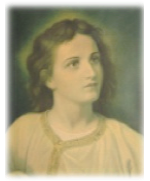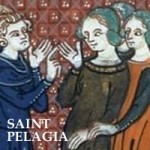Latin Mass: 4th Sunday of Lent (Laetare Sunday)
Beloved in Jesus Christ, At Holy Mass, the priest always effects the ‘double-consecration.’ That is, the Sacred Host and the Precious Blood are consecrated separately, in two separate actions, and this follows the words of Institution given by our Lord.
Mother Church says, this double consecration signifies the separation of Body and Blood. The words of Consecration are as a sword, producing the mystical immolation. Therefore, while the Holy Mass is a Sacrament that we receive, it is also a Sacrifice.
The Gospel today shows the multiplication of the loaves and fishes, a Eucharistic sign of the Mass. By Jesus’ mere word, miraculous bread is able to feed the multitudes: it’s an anticipation of what will happen at the Last Supper.
The fish, which has been a symbol of Christ since the 1st century – anticipates the sacrifice Christ will effect for us. Incidentally, the symbol of the fish will appear again after the resurrection, when Our Lord meets the apostles on the beach. There, a fish is over the fire – it is an image of sacrifice, an image of Christ; it says, ‘He took bread, gave it to them, and likewise the fish.’
Holy Mass is signified in other New Testament places, such as on the Road to Emmaus, when they recognize the Lord in the ‘Breaking of the Bread.’ And there are other places as well. But it is interesting, that the Sacrifice of the Mass is not only intimated in various New Testament passages, but is veiled in the Old Testament as well.
Certainly the Manna which sustained the people through the desert journey, points to Holy Communion of the new dispensation. The sacred ‘bread of the presence’ and wine in the temple foreshadowed the Holy Eucharist of the fulfilled Temple. But the sacrificial aspect of Mass was also widely foretold under the Old Law.
Fr. Arminjon[i] says, Under the Old Law, ‘the priest would extend his hands over the victim. The purpose of this was to show, that not having the right to destroy himself, he identified himself with the victim by this sign. Then he fed on the flesh of the victim so that in some way, the sacrifice might be embodied in him.’ Well, so too at Mass, the priest extends his hands over the Host; and it is also required that the priest who offers, must himself consume the sacrifice.
Thomas Aquinas teaches that all of the Old Testament rituals in some way foretold Our Lord’s coming sacrifice. ‘It is true to say that Christ was sacrificed even in the figure of the Old Testament,[ii] he says.
The sacrifice of Noah, the Bread and Wine of Melchizedeck, Abraham’s offering Isaac – these were signs. The manna and the quail – like the bread and the fish; all of the goats and the calves, and the lambs – signified the coming Lamb of God. St. Thomas says: ‘The sacrifice of the Paschal Lamb signified Christ’s Sacrifice whereby we are made holy.’[iii]
Even by the grain offering of first-fruits, the First Fruit of our redemption is foretold.[iv] The priests pray over the barley with outstretched hands, as placing their sins on it; the barley is raised up, and the Wave Offering is made to the north, the south, the east, and the west. In so-doing, they unknowingly formed a sign of the cross.[v]
But once the True Sacrifice of the cross was effected, the blood-sacrifices of the known world came to a speedy end.[vi]
The sacraments of the Old Law did not confer grace by themselves, that is ex opere operato[vii], but only by reason of their faith in Christ’s Passion which they signified, even though that faith was implicit. St. Thomas says, ‘The fathers of old were justified by faith in Christ’s Passion, just as we are.’[viii]
The event of Calvary, which we will re-live on Good Friday, it is the pinnacle of history. The sacraments of the Old Law anticipated it, and the Holy Mass of the New Law Re-presents it. Father Mersch says: ‘The redemption, emanating from the Redeemer, spreads out in all directions,[ix] ‘ ascending through the past ages as easily as the present.[x] Christ’s charity spans all ages and includes every human being.[xi]
To some people not of our fold, whose knowledge of Jesus is only within the covers of a printed book, to them his Sacrifice is finished and done with, just like closing a book. Now they only read about it.[xii] But to the soul who has an intimate knowledge of her Lord, the continual offering of the Mass is inevitably true; ‘I will be with you all days, even unto the end of the world,’ says the Lord. Scripture says that he is able to save all who seek God through him, because he lives to make intercession for us.[xiii] Jesus is always offering the Eternal Mass in heaven, in which we participate.
The Mass is the re-presentation of Calvary. Fulton Sheen[xiv] asks, how can this be? How can Christ renew the cross, he cannot suffer again in his physical body? No. But he can suffer in his Mystical Body, the Church. Calvary can be re-enacted provided we give him ourselves, that he can offer himself anew to his heavenly Father. So Christ goes out into the world gathering up other human natures who are willing to be Christs, uniting our individual human natures with the Great Sacrifice of the Cross.
The first half of Lent has emphasized repentance, our need for salvation. But now our eyes turn toward the Cross, to the saving events of Good Friday and Easter Sunday. May the Blessed Virgin pray for us, that we ourselves will become acceptable sacrifices, offered on the altar of God.
[Entrusted to the prayers of St. Nicholas]
[i] The End of the Present World, p. 246
[ii] Summa III, Q83a1
[iii] Summa, III, Q60, a2
[iv] Christ, the first fruits; then, when he comes, those who belong to him. 1 Cor 15:23
[v] Fr. James Meagher, p. 201-2
[vi] The End of the Present World, p. 246
[vii] See also Catholic Encyclopedia, under Sacraments. Also: Augustine says (Contra Faust. xix) that the sacraments of the Old Law “were abolished because they were fulfilled; and others were instituted, fewer in number, but more efficacious, more profitable, and of easier accomplishment.”
[viii] Summa, III, Q62, a6. See also Ia, IIae, Q 102, a5.
[ix] Theology of the Mystical Body, Mersch, p. 181. Also: Gueranger says: ‘God had offered them his grace, whereby they were enabled to conquer pride and concupiscence. The merits of the Redeemer to come were even then present to divine justice, and the Lamb, slain, as St. John tells us, from the beginning of the world, applied the merits of His blood to this as to every generation which existed before the great Sacrifice was really immolated. Each individual of the human family might have been just, as Noah was, and, like him, have found favor with the Most high.’ The liturgical year, Vol. 4, Septuagesima, Dom Prosper Gueranger, p. 160-161.
[x] Revelation 13:8: The Redemption is eternal: Christ ‘was slain from the beginning of the world.’
[xi] The Theology of Pope Benedict XVI, p. 138.
[xii] The Friendship of Christ, Benson, p. 51-2.
[xiii] Heb 7:25
[xiv] Calvary and the Mass, Sheen, p. 41, 44.


